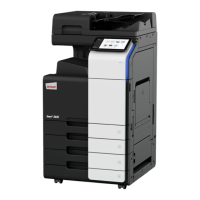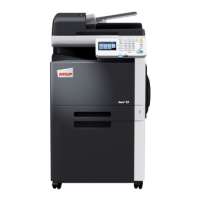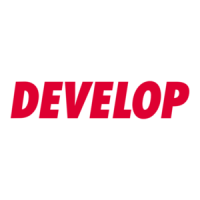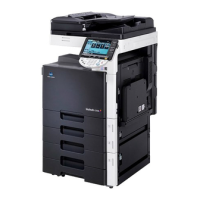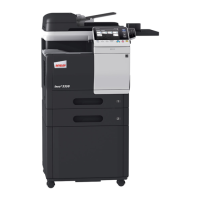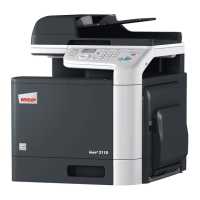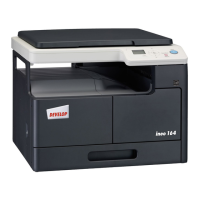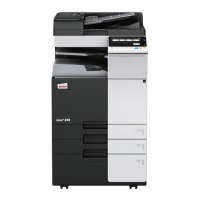Do you have a question about the Develop ineo+360 and is the answer not in the manual?
Details the machine's compliance with ENERGY STAR® guidelines for energy efficiency.
Explains warning symbols, their meanings, and general safety precautions for machine operation.
Information on US FCC, Canadian ICES, and laser safety classifications and precautions.
Notice regarding European PSTN connection approvals and operational assurances.
Specifies power source requirements and operating environmental conditions for optimal machine performance.
Introduction to the Quick Guide book and the various User's Guide modules on the DVD.
How to display functional descriptions and operating procedures using the Guidance screen.
Instructions for powering the machine on and off using main and sub power switches.
Instructions for loading paper into trays, LCT, and bypass tray.
Illustrates jam locations and how to use the guidance function for clearing.
Step-by-step procedure for clearing paper jams within the Automatic Document Feeder (ADF).
Instructions for clearing paper jams from the right-side door, with heat caution.
Procedure for clearing paper jams from the paper tray, including door closing notices.
Steps to clear paper jams from Finisher FS-527, FS-529, and Job Separator JS-505.
Procedures for clearing staple jams from Finisher FS-527, SD-509, and FS-529.
Detailed steps for replacing the toner cartridge, including notices and cautions.
Procedure for replacing the waste toner box, including toner spill cautions.
Step-by-step instructions for replacing a drum unit, with notices and toner spill cautions.
Procedures for replacing staple cartridges in Finishers FS-527, SD-509, and FS-529.
Procedure for emptying the punch scrap box for finisher FS-527.
General operation for copying, including document positioning and login procedures.
Instructions for sending print data from a computer application via the printer driver.
General operation for sending faxes, starting with changing the mode and login.
Details methods for sending scanned documents via email, FTP, SMB, WebDAV, and Web Service.
Overview of the Quick Copy screen for convenient access to basic and color copy settings.
Method for printing on both sides of the paper to halve paper usage for large document sets.
Instructions for combining multiple document pages onto a single sheet (2-in-1, 4-in-1, 8-in-1).
Procedure for scanning documents in batches when unable to load all pages into the ADF.
Copies pages of a spread document, arranging order and printing double-sided.
Feature to erase unwanted areas like transmission information or punched hole shadows from copies.
Automatically selects zoom ratio based on document and paper size for enlarged/reduced copies.
Enables stapling documents at corners or two locations, and punching holes for filing.
Instructions for using the bypass tray for copying onto envelopes, emphasizing orientation.
Allows registering frequently used functions as copy programs for easy recall and use.
Enables creating shortcut or easy setting keys on the basic settings screen for frequently used functions.
Allows checking a single proof copy or print image before printing large numbers to correct errors.
Allows checking the total number of printed pages and detailed counts for various functions.
Details automatic entry into power-saving modes (Low Power, Sleep) when the machine is idle.
Selecting paper type, size, and orientation (Portrait/Landscape) for printing.
Specifying zoom ratios and selecting paper trays or types for printing.
Selecting collation for complete sets and offset for shifting copies.
Securing confidential documents with passwords and organizing documents in user boxes.
Checking print proofs and controlling access via user authentication or account track.
Printing confidential jobs from ID & Print User Box after user authentication.
N-in-1 printing and double-sided printing to reduce paper usage and create booklets.
Specifying binding direction, margins, and shifting the image for printing.
Binding printed documents with staples or punching holes, and folding copies.
Printing covers on different paper and feeding interleaves between transparencies.
Adding watermarks, overlays, and implementing copy protection features.
Adjusting print quality, tone, and color settings for optimal document reproduction.
Applying a glossy finish to the printed document.
Replacing TrueType fonts with printer fonts to reduce printing time.
Customizing the printer driver interface by registering frequently used functions in one tab.
Registering frequently used fax numbers in the address book for easy recall.
Registering multiple destinations together as a single group for efficient recipient selection.
Registering scanning, transmission settings, and destinations for one-button recall.
Viewing and printing logs of transmissions and receptions in reports like Transmission, Reception, and Activity.
Sending a document to multiple recipients with a single operation using keypad or registered destinations.
Selecting multiple destinations from the address book or groups for transmission.
Selecting and changing registered transmission source information (name and fax ID).
Adjusting image quality, resolution, density, file type, and document name for scanned documents.
Adjusting background removal and sharpness for scanned documents.
Specifying settings for Frame Erase, Book Copy, Annotation, Stamp/Composition.
Sending scanned documents upon request from the recipient, where the recipient incurs transmission costs.
Sending documents to a representative recipient who then forwards them to remaining recipients.
Scheduling fax transmissions for late-night hours to take advantage of lower telephone charges.
Sending scanned documents as email attachments via the Internet, with costs included in internet charges.
Enabling communication on an intranet by specifying recipient IP address or host name.
Sending scanned data as an email attachment by specifying the recipient's email address.
Saving received faxes in a user box for selective printing to reduce costs and enhance security.
Sending faxes with a confidential user box (SUB address) and password for document confidentiality.
Forwarding received fax data to a previously specified destination.
Sending data created on a computer as a fax using the installed fax driver.
Registering frequently used destinations in the address book for easy recall.
Registering multiple destinations together as a single group for efficient recipient selection.
Registering scanning and transmission settings with destinations for one-button recall.
Specifying higher resolution for improved image quality when scanning fine text and images.
Choosing appropriate scanning methods (Text, Text/Photo, Photo) for document types.
Choosing color settings and file types (PDF, TIFF, JPEG, XPS) for scanned documents.
Option to add page numbers to the scanned document for easier identification.
Option to add the date and time of scanning to the transmitted document.
Adjusting background density to output clear scan data, removing back-side print or colored backgrounds.
Erasing unwanted areas like transmission information or punched hole shadows from scanned documents.
Locating and selecting registered destinations from the address book for sending documents.
Sending scanned data as an email attachment by specifying the recipient's email address.
Viewing lists of currently performing jobs and historical completed transmission jobs.
Renaming documents saved in user boxes for easier identification and recall.
Configuring scan settings, including selecting '2-Sided' for scanning double-sided documents.
Specifying a time limit for saving data in user boxes; data is automatically erased after this period.
Printing or sending multiple data items saved in user boxes together, specifying order and finishing.
Changing finishing settings like sort, group, offset, staple, and punch before printing saved data.
Using Web Connection via a web browser to manage user boxes and machine settings remotely.
Functions like Web browser and Image Panel enabled by registering i-Option LK-101 v2.
Centrally managed control panel and address book accessible across selected MFPs.
Procedure for registering i-Options to the MFP to enable their functions, via control panel or web.
Troubleshooting steps for when the machine does not power on, checking switches and outlets.
Steps to resolve issues with the touch panel display, including brightness and power save modes.
Addresses messages related to consumables and cleaning, guiding replacement or cleaning procedures.
Troubleshooting steps for persistent paper jam messages, checking paper paths and doors.
Explanation of the image stabilization function for maintaining stable color reproduction quality.
Guidance on clearing different types of errors and contacting service if issues persist.
Overview of the User Settings screen for specifying various machine and function settings.
Adjusting display language, measurement units, and power-saving modes.
Customizing touch panel display, basic screen settings, and copier function settings.
Configuring settings for scan, fax, and print functions to easily perform operations.
Definitions of key terms used throughout the manual for better understanding.
Information regarding software trademarks, copyrights, and licensing agreements.
| Print Technology | Laser |
|---|---|
| Print Speed (Black) | 36 ppm |
| Print Speed (Color) | 36 ppm |
| Copy Speed (Black) | 36 cpm |
| Copy Speed (Color) | 36 cpm |
| Copy Resolution | 600 x 600 dpi |
| Scan Resolution | 600 x 600 dpi |
| Fax Speed | 33.6 Kbps |
| Duplex Printing | Yes |
| Network Connectivity | Ethernet, USB |
| Functions | Print, Copy, Scan |
| Operating System Compatibility | Windows, Mac |
| Color Capability | Yes |
